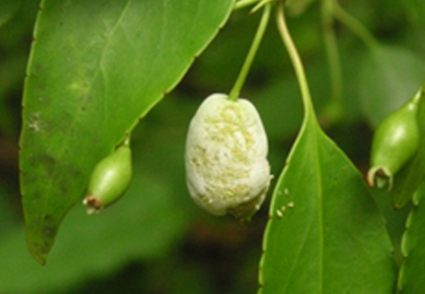Abstract
Fruit deformation of Symplocos myrtacea Siebold et Zuccarini (Japanese sapphireberry) caused by Exobasidium species has been reported in Fukuoka Prefecture, Japan but the species involved has not been determined (Ogawa 1999, 2000). Five species and varieties of Exobasidium were recorded on Symplocos species previously (Sydow et al. 1912, Hirata 1981, Ezuka 1991, Nagao et al. 2003). Exobasidium symploci Ell. &Mart. was identified on S. tinctoria (L.) L’Hér. in Alabama, Florida, Indiana, and North Carolina, USA. Two Exobasidium spp. were recorded from Tropical Asia: E. indicum Syd. & Butl. on S. theaefolia D. Don in Darjeeling and E. javanicum Rac. on S. spicata var. subsessilis Koord. & Valeton (syn. S. cochinchinensis subsp. laurina (Retz.) Noot.) in Java. In Japan, the following Exobasidium spp. were described on Symplocos species: E. symploci-japonicae var. symploci-japonicae Kusano & Tokubuchi and E. symploci-japonicae var. caprogenum Nagao & S. Ogawa on S. lucida (syn. S. kuroki Nagam.), and E. sakataniense S. Hirata on S. theophrastaefolia Siebold & Zucc.
References
Hirata, S. (1981) A new species of Exobasidium parasitic on Symplocos theophrastaefolia. Transactions of the Mycological Society of Japan 22: 61–63.
Nagao, H., Kakishima, M., Ogawa, S. & Sato, T. (2003) Exobasidium symploci–japonicae var. carpogenum var. nov. causing Exobasidium fruit deformation on Symplocos lucida in Japan. Mycoscience 44: 369–375. https://doi.org/10.1007/S10267-003-0126-Z
Ogawa, S. (1999) Diseases of ornamental trees observed in Fukuoka (?). On diseases observed from 1995 to 1998. Kenronbunsyu of Kyushu Branch of the Japanese Forestry Society 52: 91–92. [in Japanese]
Ogawa, S. (2000) New diseases of trees recorded in Fukuoka Pref. (II) (in Japanese). Forest Pests 49: 28–33.
Sydow, H., Sydow, P. & Butler, E.J. (1912) Fungi Indiae orientalis IV. Annales Mycologici 10: 279.


